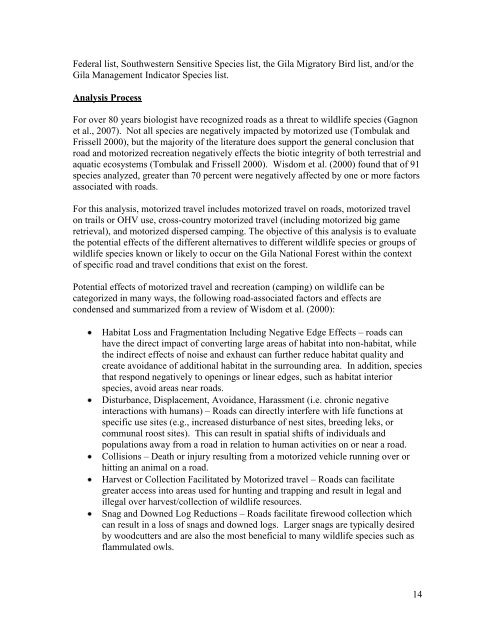Wildlife Specialist report
Wildlife Specialist report
Wildlife Specialist report
Create successful ePaper yourself
Turn your PDF publications into a flip-book with our unique Google optimized e-Paper software.
Federal list, Southwestern Sensitive Species list, the Gila Migratory Bird list, and/or the<br />
Gila Management Indicator Species list.<br />
Analysis Process<br />
For over 80 years biologist have recognized roads as a threat to wildlife species (Gagnon<br />
et al., 2007). Not all species are negatively impacted by motorized use (Tombulak and<br />
Frissell 2000), but the majority of the literature does support the general conclusion that<br />
road and motorized recreation negatively effects the biotic integrity of both terrestrial and<br />
aquatic ecosystems (Tombulak and Frissell 2000). Wisdom et al. (2000) found that of 91<br />
species analyzed, greater than 70 percent were negatively affected by one or more factors<br />
associated with roads.<br />
For this analysis, motorized travel includes motorized travel on roads, motorized travel<br />
on trails or OHV use, cross-country motorized travel (including motorized big game<br />
retrieval), and motorized dispersed camping. The objective of this analysis is to evaluate<br />
the potential effects of the different alternatives to different wildlife species or groups of<br />
wildlife species known or likely to occur on the Gila National Forest within the context<br />
of specific road and travel conditions that exist on the forest.<br />
Potential effects of motorized travel and recreation (camping) on wildlife can be<br />
categorized in many ways, the following road-associated factors and effects are<br />
condensed and summarized from a review of Wisdom et al. (2000):<br />
Habitat Loss and Fragmentation Including Negative Edge Effects – roads can<br />
have the direct impact of converting large areas of habitat into non-habitat, while<br />
the indirect effects of noise and exhaust can further reduce habitat quality and<br />
create avoidance of additional habitat in the surrounding area. In addition, species<br />
that respond negatively to openings or linear edges, such as habitat interior<br />
species, avoid areas near roads.<br />
Disturbance, Displacement, Avoidance, Harassment (i.e. chronic negative<br />
interactions with humans) – Roads can directly interfere with life functions at<br />
specific use sites (e.g., increased disturbance of nest sites, breeding leks, or<br />
communal roost sites). This can result in spatial shifts of individuals and<br />
populations away from a road in relation to human activities on or near a road.<br />
Collisions – Death or injury resulting from a motorized vehicle running over or<br />
hitting an animal on a road.<br />
Harvest or Collection Facilitated by Motorized travel – Roads can facilitate<br />
greater access into areas used for hunting and trapping and result in legal and<br />
illegal over harvest/collection of wildlife resources.<br />
Snag and Downed Log Reductions – Roads facilitate firewood collection which<br />
can result in a loss of snags and downed logs. Larger snags are typically desired<br />
by woodcutters and are also the most beneficial to many wildlife species such as<br />
flammulated owls.<br />
14
















